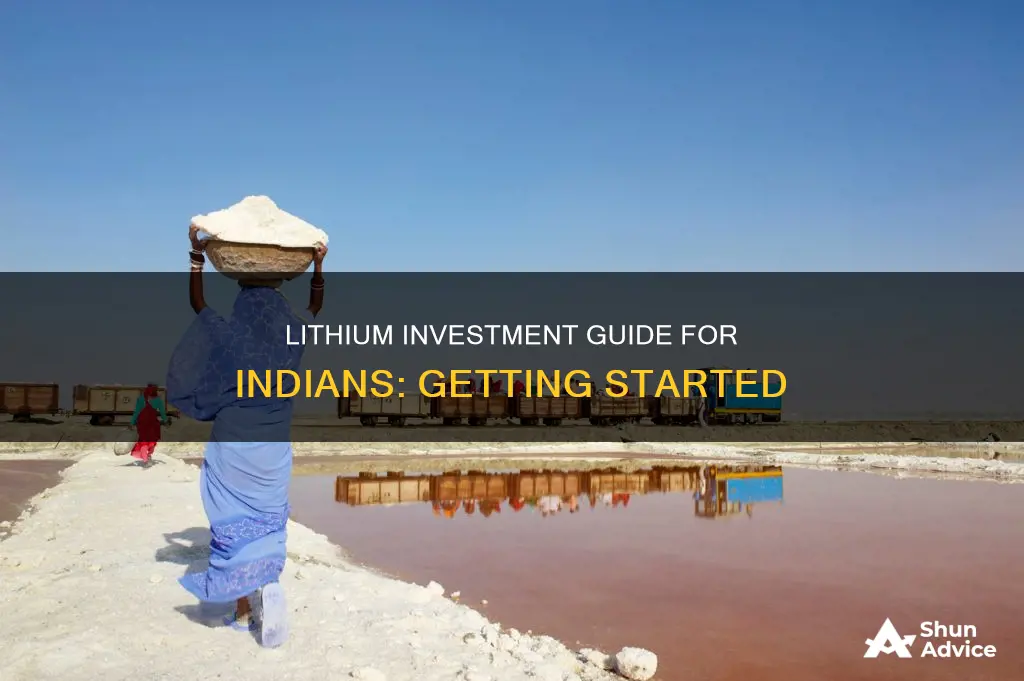
Lithium is the lightest metal on the periodic table and is a key component in battery manufacturing. It is the basis of the lithium-ion battery, which powers electric vehicles (EVs) and is used in many consumer products such as computers and smartphones. In February 2023, the Geological Survey of India (GSI) announced the discovery of 5.9 million metric tonnes of inferred resources of lithium in the Salal-Haimana area of Jammu & Kashmir. Valued at $34 trillion, this discovery has put India on the map as an EV hub.
With the Indian government's interest in the industry and the expected growth of the battery market in India, investing in lithium in India is an attractive prospect. However, it is important to note that investing in commodities can be risky and it is recommended to conduct extensive research before investing.
What You'll Learn

The discovery of lithium in India and its impact on the stock market
In February 2023, the Geological Survey of India (GSI) announced the discovery of 5.9 million metric tonnes (MMT) of inferred resources of lithium in the Salal-Haimana area of Jammu & Kashmir. This discovery has significant implications for India's economy and its transition to a green, electric vehicle-powered future.
The Impact of the Discovery
The lithium discovery in India has been hailed as a game-changer, with the country joining the ranks of the world's top lithium producers. At the time of the announcement, the inferred resources were estimated to be worth $34 trillion, a staggering figure compared to India's $3.5 trillion economy. This discovery boosts India's strategic importance and reduces its dependence on lithium imports from Australia and Argentina.
Stock Market Opportunities
The discovery has sparked excitement in the stock market, with investors eyeing opportunities in the entire EV ecosystem, from mining companies to battery manufacturers and vehicle producers. The focus is on identifying multibagger stocks that will benefit from India's newfound lithium reserves.
Challenges and Concerns
However, it's important to note that the discovery is still in the preliminary exploration stage, and the final reserve amount that can be mined will likely be lower. Additionally, there are social and environmental concerns associated with lithium mining in the region, including potential human displacement and ecological damage. The process of lithium extraction is complex and has the potential to cause environmental degradation, including water depletion and contamination, loss of biodiversity, and air pollution.
A Balanced Approach
To address these challenges, the Indian government and industry are promoting the 'Rare Earths Mission' to responsibly exploit the country's critical mineral reserves. The government plans to hold auctions for the reserves, with the condition that refined lithium can only be processed within India. This discovery presents a unique opportunity for India to attract investment in domestic battery manufacturing and clean energy technologies while also addressing energy poverty and sustainable development goals.
In conclusion, the discovery of lithium in India has far-reaching implications for the stock market and the country's economic future. With a careful and balanced approach, India can leverage this discovery to become a global leader in the transition to renewable energy and electric vehicles while also addressing social and environmental concerns.
Portfolio Optimization: Strategies for Maximizing Returns
You may want to see also

The challenges and opportunities in the Indian battery market
The Indian battery market is highly fragmented, with several major players, including Exide Industries Ltd, HBL Power Systems Ltd, Luminous Power Technologies Pvt. Ltd, TATA AutoComp GY Batteries Pvt. Ltd, and Okaya Power Pvt. Ltd. The market is segmented by technology (lithium-ion battery, lead-acid battery, etc.), application (SLI batteries, industrial batteries, stationary batteries, etc.), portability (consumer electronics, etc.), and automotive batteries (HEV, PHEV, and EV).
The Indian battery market faces some challenges, such as the absence of domestic manufacturing capabilities for lithium-ion batteries, which has led to a reliance on imports and hindered the industry's growth. However, the market also presents several opportunities for investors. Here are some of the key challenges and opportunities:
Challenges:
- The absence of lithium-ion battery manufacturing in India has resulted in a reliance on imports, hindering the industry's growth.
- The lockdown measures imposed by the government to stop the spread of Covid-19 significantly impacted the shipping routes for lithium-ion and lead-acid battery manufacturing units in the country.
Opportunities:
- The introduction of government initiatives and the growing popularity of electric vehicles (EVs) are expected to drive the demand for batteries in India.
- The NITI Ayog report highlights the country's budding prospect for large-scale battery manufacturing industries, with India expected to surpass Rs 1.12 trillion in the battery market and witness a volcanic scheme of demand between 2050-2030.
- The government's interest and initiatives in boosting battery manufacturing in India, such as the Production-linked Incentive (PLI) program, are expected to create a huge market for investors.
- The annual lithium-ion battery market in India is projected to grow to 116 GWh in FY 2029-30, driven by favourable government policies and state-level EV policies.
- The demand for lithium batteries in the non-automotive capacitive is also expected to increase to around 12 GWh, driven by telecom towers, grid-scale renewable energy integration, data centres, and rooftop solar.
- The government of India has set a target of about 30% of new electric vehicle sales by 2030, which will further drive the nation's adoption of lithium batteries.
- The plans for in-house manufacturing of lithium-ion batteries in India are expected to reduce EV costs and import duties, creating opportunities for the lithium-ion battery market in the country.
Market Downturn: Understanding Your Portfolio's Monthly Decline
You may want to see also

The role of the government in promoting battery manufacturing
The Indian government has taken several steps to promote battery manufacturing in the country. Here is an overview of its role:
Incentivizing Local Manufacturing
The Indian government is incentivizing the local manufacturing of batteries to reduce the economy's reliance on costly imports from China or Taiwan. It aims to promote "Make in India" by offering incentives such as the Production Linked Incentive (PLI) scheme for battery makers. This scheme provides a financial incentive of INR 18,100 crore over five years to encourage local production. The government has also increased import duties on lithium-ion cells and assembled battery packs to further motivate local manufacturing.
Facilitating Technology Transfer
The government, through the Indian Space Research Organization (ISRO), has transferred its indigenously developed low-cost lithium-ion cell technology to several companies. This technology transfer aims to boost local manufacturing capabilities and reduce India's dependence on foreign suppliers.
Creating an Ecosystem for Battery Manufacturing
The government is keen on creating an ecosystem conducive to battery manufacturing. It has engaged in discussions with battery makers, urging them to set up manufacturing units in India to meet the future demand for batteries, especially with the push for electric vehicles (EVs). The government has also initiated interactions with resource-rich countries like Bolivia to secure raw materials for battery production.
Addressing Industry Concerns
The government has been receptive to the concerns raised by the battery industry. For instance, it has assured manufacturers that it will take measures to address the high goods and services tax (GST) rates on batteries. It has also shown support for giving preference to Indian manufacturers in government procurement processes to promote the "Make in India" initiative.
Promoting Research and Development
The government recognizes the importance of research and development in battery technology. It has encouraged local universities and industry firms to foster intensive cooperation in this field. Additionally, the government has established the National Mission on Transformative Mobility and Battery Storage in 2019 to drive mobility initiatives and promote large-scale manufacturing plants for cells, batteries, and other components of the EV value chain.
CDs: Investment or Saving?
You may want to see also

The demand for lithium-ion batteries in the automotive sector
Lithium-ion batteries have successfully penetrated the automotive market due to their long life, compact size, less charging time, and low maintenance costs compared to traditional batteries. The global automotive lithium-ion battery market was valued at $17.4 billion in 2019 and is projected to reach $95.3 billion by 2030, representing a compound annual growth rate (CAGR) of 17.1%.
The demand for lithium-ion batteries in electric vehicles, including e-bikes, e-rickshaws, and e-cars, is a key factor driving the market growth. The shift towards electric vehicles is accelerated by government initiatives, such as India's plan to sell only electric two-wheelers from 2025 and South Africa's target to incorporate 20% electric cars by 2030.
Additionally, advancements in battery technology have resulted in higher energy density and longer lifespans, making lithium-ion batteries even more attractive for automotive applications. For example, NMC (Nickel Manganese Cobalt) chemistries are known to increase the energy density and lifespan of lithium-ion batteries, leading to increased investment in this area.
The demand for lithium-ion batteries is also influenced by the push for renewable energy sources and the need for energy storage solutions. The integration of lithium-ion batteries in energy storage systems (BESS) contributes significantly to the overall demand for these batteries.
Furthermore, the declining prices of batteries and the increasing fossil fuel prices make electric vehicles a more attractive option for consumers. This trend is expected to drive the demand for lithium-ion batteries in the automotive sector even further.
Overall, the combination of these factors indicates a strong and growing demand for lithium-ion batteries in the automotive sector, presenting opportunities for investment and market growth.
Savings-Investment Identity: Understanding the Logical Balance
You may want to see also

The risks and benefits of investing in lithium
Lithium is a soft, silver-white metal that is extremely light. It is a key component in the production of rechargeable batteries, which are used to power portable devices and electric vehicles (EVs). As the demand for EVs and consumer electronics increases, so does the demand for lithium. This makes investing in lithium an attractive prospect for many. However, there are risks to consider as well.
Benefits of Investing in Lithium
- Increasing Demand: The transition to a low-carbon economy and the growth of the EV market are expected to increase the demand for lithium exponentially. By the end of the decade, 95% of lithium demand will come from batteries, up from just 30% in 2015.
- High Value: The recent discovery of 5.9 million metric tonnes of lithium in India is estimated to be worth $34 trillion, which is significantly more than the size of India's economy. This discovery has put India on the map in the EV market and reduced its dependence on China for EV batteries.
- Diversification: Investing in lithium provides exposure to a range of industries, including mining, processing, and compound manufacturing. It also offers geographic diversification, as lithium production is concentrated in South America, Asia, and Australia.
- Potential for Growth: The supply of lithium is currently constrained due to the complex extraction process and limited production technologies. However, new technologies such as direct lithium extraction (DLE) are expected to bolster supply in the coming years, leading to investment opportunities for companies that can meet the growing demand.
- Long-term Growth Opportunities: Lithium batteries are the default choice in EVs, energy storage for solar and wind power, and consumer electronics. The growth in these industries presents long-term growth opportunities for companies involved in the lithium supply chain.
Risks of Investing in Lithium
- Volatility: The lithium market is subject to volatility due to various factors such as oversupply, fluctuations in demand, and government regulations. Lithium prices have been on a downward trend in recent years, hitting a three-year low in the third quarter of 2024.
- Geopolitical Tensions: Lithium production is geographically concentrated, with 98% of it occurring in South America, Asia, and Australia. Geopolitical tensions and government interventions, such as the nationalization of lithium deposits, can impact access to lithium and create uncertainties for investors.
- Environmental and Regulatory Constraints: Government regulations and environmental concerns can limit the ability of companies to rapidly expand production. The typical lithium project requires 3-7 years to finance and build, and strict environmental rules must be followed during the complex mining and extraction process.
- Competition and Technological Changes: The lithium industry is highly competitive, with companies racing to participate in the market. Additionally, technological changes and advancements in battery technology could disrupt the market and impact the performance of lithium stocks.
- Financial Risk: Investing in lithium, especially through complex instruments such as spread bets and CFDs, carries a high risk of losing money rapidly. It is important for investors to understand the complexities of the lithium supply chain and carefully consider their risk tolerance before investing.
In conclusion, investing in lithium offers opportunities for those seeking exposure to the EV and renewable energy markets. However, it is important to carefully consider the risks and volatility inherent in this market. Investors should conduct thorough research and due diligence before making any investment decisions.
Mastering Investment Projections with Spreadsheets: A Comprehensive Guide
You may want to see also
Frequently asked questions
Lithium is an integral component in the production of rechargeable batteries. These batteries are used to power portable devices, such as smartphones and tablets, and electric vehicles.
You can invest in lithium indirectly by investing in companies that use or supply lithium, such as Panasonic, Livent, Samsung, LG, Panasonic, CATL, Tesla, Rivian, General Motors, Lucid Group, and Ford. You can also invest in lithium producers that are publicly traded, like Albermarle Corp.
Any investment in future-oriented technology is a gamble. There is always the possibility that someone could invent a better battery tomorrow, reducing the demand for lithium.
Lithium stocks are the shares of companies that engage in the mining or processing of lithium.
Albemarle Corp., Mineral Resources Ltd., Sociedad Química y Minera de Chile SA, Arcadium Lithium PLC, and Ganfeng Lithium Group Co. Ltd.







